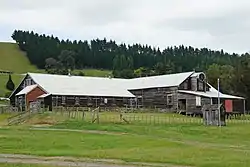Maraekakaho
Maraekakaho is a rural settlement in the Hastings District and Hawke's Bay Region of New Zealand's North Island.
Maraekakaho | |
|---|---|
Settlement | |
 Woolshed in Maraekakaho | |
| Coordinates: 39.648668°S 176.617552°E | |
| Country | New Zealand |
| Region | Hawke's Bay Region |
| Territorial authority | Hastings District |
| Ward |
|
| Community | Hastings District Rural Community |
| Electorates | |
| Government | |
| • Territorial Authority | Hastings District Council |
| • Regional council | Hawke's Bay Regional Council |
| Postcode(s) | 4171 |
The main village was developed by Sir Douglas Maclean in the early 20th century, on a pastoral station established by his father, Sir Donald McLean, during the 19th century. The surrounding area includes lifestyle blocks, vineyards and wineries, orchards and pastoral farms.[1]
Maraekakaho is a Māori name, translating as the area (marae) of the culm of the toetoe (kakaho); the grasses were once very common in the area.[1]
A war memorial was set up in the settlement in 1986, commemorating the approximately 100 local men killed during World War I.[2]
The Kereru Homestead and Station was established in 1857 on land purchased by the government from local Māori at the base of the Ruahine Ranges. It features mixed terrain, including flat land, rolling hills and ravines.[3][4]
Demographics
Maraekakaho statistical area covers 820.41 km2 (316.76 sq mi)[5] and had an estimated population of 1,550 as of June 2022,[6] with a population density of 1.9 people per km2.
| Year | Pop. | ±% p.a. |
|---|---|---|
| 2006 | 1,185 | — |
| 2013 | 1,311 | +1.45% |
| 2018 | 1,392 | +1.21% |
| Source: [7] | ||
Maraekakaho had a population of 1,392 at the 2018 New Zealand census, an increase of 81 people (6.2%) since the 2013 census, and an increase of 207 people (17.5%) since the 2006 census. There were 480 households, comprising 711 males and 684 females, giving a sex ratio of 1.04 males per female. The median age was 42.5 years (compared with 37.4 years nationally), with 318 people (22.8%) aged under 15 years, 195 (14.0%) aged 15 to 29, 711 (51.1%) aged 30 to 64, and 171 (12.3%) aged 65 or older.
Ethnicities were 93.1% European/Pākehā, 13.4% Māori, 1.1% Pacific peoples, 1.5% Asian, and 0.9% other ethnicities. People may identify with more than one ethnicity.
The percentage of people born overseas was 13.6, compared with 27.1% nationally.
Although some people chose not to answer the census's question about religious affiliation, 55.2% had no religion, 35.1% were Christian, 1.3% had Māori religious beliefs and 1.3% had other religions.
Of those at least 15 years old, 282 (26.3%) people had a bachelor's or higher degree, and 147 (13.7%) people had no formal qualifications. The median income was $41,600, compared with $31,800 nationally. 237 people (22.1%) earned over $70,000 compared to 17.2% nationally. The employment status of those at least 15 was that 654 (60.9%) people were employed full-time, 204 (19.0%) were part-time, and 18 (1.7%) were unemployed.[7]
Education
Maraekakaho School is a co-educational state primary school,[8] with a roll of 120 as of April 2023.[9][10]
Kererū School is a co-educational state primary school,[11] with a roll of 26 as of April 2023.[9][12]
References
- "Maraekakaho". nzhistory.govt.nz. Ministry for Culture and Heritage.
- Austin, Glenn (2010). "Maraekakaho war memorial". nzhistory.govt.nz. Ministry for Culture and Heritage.
- "Kereru history in print". New Zealand Media and Entertainment. Hawke's Bay Today. 27 June 2015.
- Morgan, Joy (25 June 2013). "Winning couple learn from hard lessons". stuff.co.nz. Farming Stuff.
- "ArcGIS Web Application". statsnz.maps.arcgis.com. Retrieved 31 January 2023.
- "Population estimate tables - NZ.Stat". Statistics New Zealand. Retrieved 25 October 2022.
- "Statistical area 1 dataset for 2018 Census". Statistics New Zealand. March 2020. Maraekakaho (208200). 2018 Census place summary: Maraekakaho
- "Maraekakaho School Ministry of Education School Profile". educationcounts.govt.nz. Ministry of Education.
- "New Zealand Schools Directory". New Zealand Ministry of Education. Retrieved 12 December 2022.
- "Maraekakaho School Education Review Office Report". ero.govt.nz. Education Review Office.
- "Kereru School Ministry of Education School Profile". educationcounts.govt.nz. Ministry of Education.
- "Kereru School Education Review Office Report". ero.govt.nz. Education Review Office.